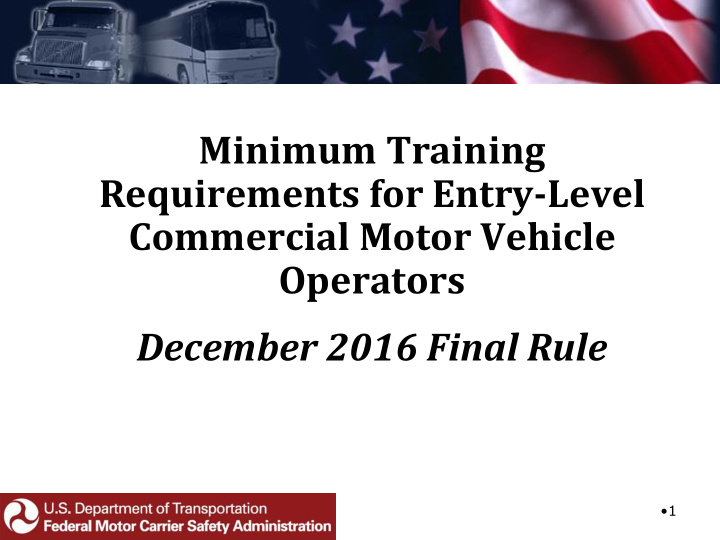



Minimum Training Requirements for Entry-Level Commercial Motor Vehicle Operators December 2016 Final Rule • 1
What Does the Rule Require? The final rule establishes new training standards for individuals applying for: • A Class A or B commercial driver’s license (CDL) for the first time; • An upgrade of their CDL (e.g., a Class B CDL holder seeking a Class A CDL); or, • A hazardous materials (H), passenger (P), or school bus (S) endorsement for the first time. The rule does not cover individuals for whom States have waived the CDL skills test under 49 CFR 383. • 2
What are CDL applicants required to do? • CDL applicants subject to the rule must complete a prescribed program of instruction presented by an entity listed on FMCSA’s Training Provider Registry (TPR ), prior to taking the State-administered CDL skills test, or for the H endorsement, prior to taking the knowledge test . • TPR will include all entities (including public and private CDL training programs, fleet-operated CDL training programs, etc.) that register with FMCSA and self-certify they meet the requirements for providing CDL training (minimum criteria for CDL instructors, facilities, curriculum, etc.) . • 3
What types of training will CDL applicants receive? • The Class A and B CDL and endorsement curricula generally are subdivided into theory (knowledge) and behind-the-wheel (BTW) (range and public road) segments. • There is no minimum number of hours that driver-trainees must spend on the theory portions of any of the individual curricula. • The training provider must provide instruction in all elements of the applicable theory curriculum and driver- trainees must receive an overall score of at least 80 percent on the theory assessment (written or electronic). • 4
What types of training will CDL applicants receive? (Continued) • The BTW curricula for the Class A and Class B CDL, comprised of range and public road segments, include discrete maneuvers which each driver-trainee must proficiently demonstrate to the satisfaction of the training instructor. • There is no minimum number of hours that driver-trainees must spend on the BTW elements of the Class A, Class B, or P or S endorsement curricula. • The training provider must not issue the certification information unless the driver-trainee demonstrates proficiency in performing all required BTW skills. • 5
What happens when the CDL applicants complete the training? • Training providers must transmit electronically the training certification information for each student to FMCSA via the TPR when the student completes the course. • FMCSA will transmit electronically the training certification information to the State Driver Licensing Agency (SDLA) as proof the CDL applicant has completed the training prior to taking the State-administered CDL skills test, or for the H endorsement, prior to taking the knowledge test. • The SDLAs must modify their IT systems to receive the certification information from FMCSA and to post that information on the applicant’s CDLIS driver record. • 6
When will the new requirements be implemented? • The ELDT rule will be implemented on February 7, 2020. • Individuals who obtain a CLP on or after February 7, 2020, would have to satisfy the applicable requirements. • Individuals who obtain a CLP before February 7, 2020 are not required to comply with the new ELDT rule as long as they obtain the CDL or endorsement before the CLP (or renewed CLP) expires. • 7
Where can I get additional details about the rule? • To learn more about the final rule, please visit: http://www.fmcsa.dot.gov/eldt • You may also contact FMCSA’s Office of Policy at: Federal Motor Carrier Safety Administration Office of Policy (MC-P) 1200 New Jersey Avenue, SE Washington, DC 20590 Telephone: 202-366-2551 • 8
Recommend
More recommend